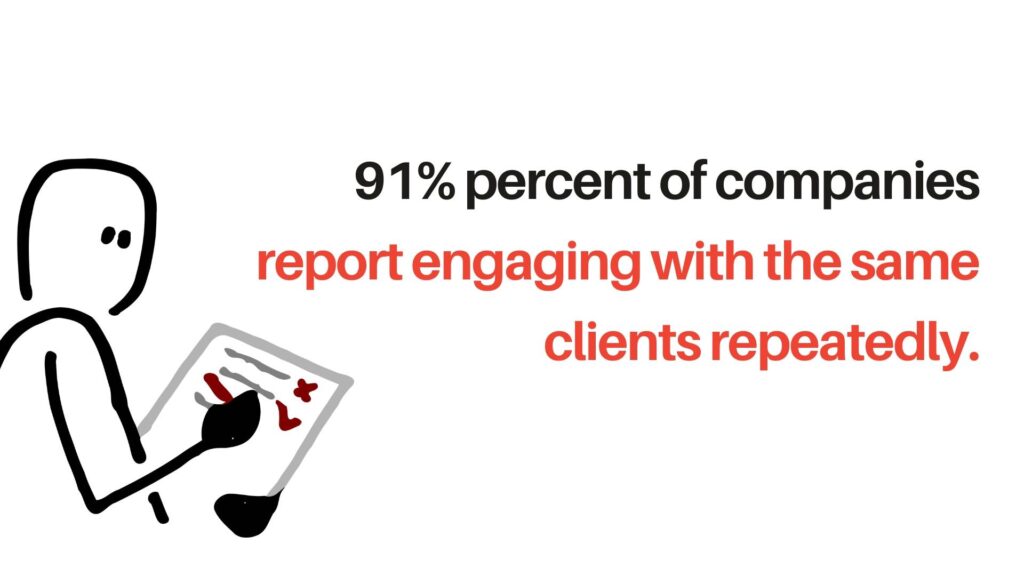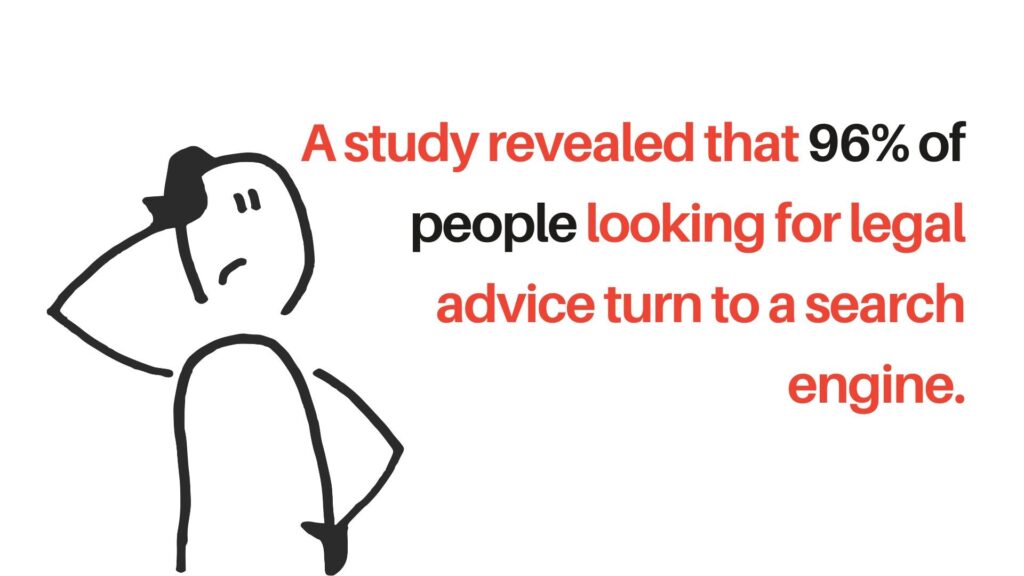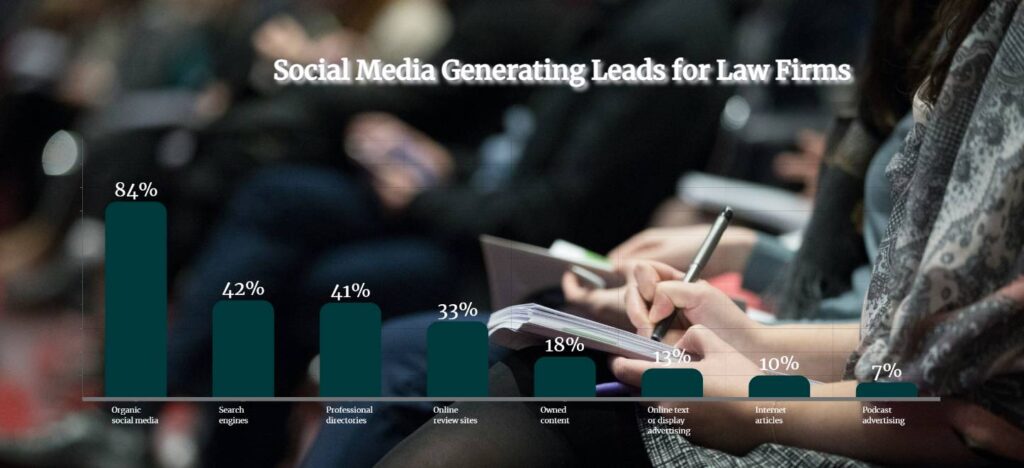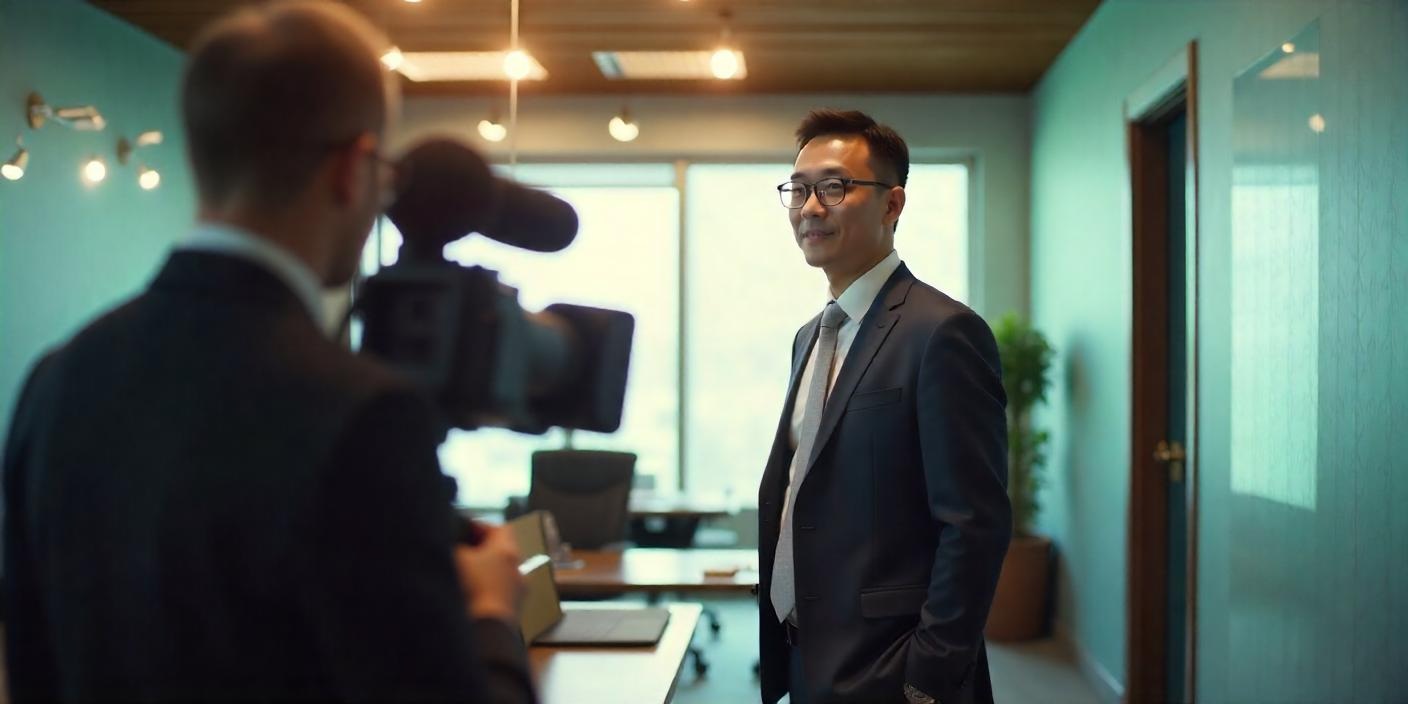Talking about legal services can feel pretty intense for clients, as if they are weighing their shoulders.
But if we say your law firm could speak directly to someone scrolling through their phone, you would be just a screen away, where you would share rights in plain language.
That’s what video marketing will do for you. It will build trust among clients before they even walk through your door!
What you are about to see with video marketing is:
- It will humanize your firm and make legal topics more accessible.
- Improves search ranking and draws traffic to your site
- Even small firms can compete by creating authentic and consistent content
- Videos will follow the ABA rules and protect clients’ confidentiality
- Make blogs, FAQs, and past cases as video material for audiences
What Are the Benefits of Video Marketing for Law Firms?
A whopping 83% of law firms are bringing in outside marketing help to achieve their marketing goals. Why wouldn’t they?
In a profession like law, where trust and clarity are everything. Video marketing is the only way to stand against a sea of text-heavy websites.
What video marketing does for law firms is:
- The law can feel intimidating. Video marketing simplifies legal topics in a calm, friendly tone on video.
- People want to hire someone they feel they can trust. Video lets them see your face, hear your voice, and get a sense of who you are.
- High-quality video content shows you’re modern, updated, and invested in your clients’ experience.
- Instead of repeating the same info over the phone or in emails, you can direct clients to helpful videos.
Here are the major benefits a law firm gets from video marketing in today’s time.
How Does Video Content Increase Client Engagement and Retention?
People LOVE video. It’s fast, visual, and feels more human.
When you create content that speaks to your audience’s problems, they’re way more likely to stick around.
- Videos pop more than text.
- Users are likelier to watch a video than read a paragraph on your site or social media.
- If your content is helpful, such as “What to do after a car accident” or “5 things to know before divorce,” they’ll return for more.
- Clear videos explaining your services help clients remember and trust you.

[Source: Legal Marketing Statistics 2025]
Can Videos Improve a Law Firm’s Online Visibility and SEO Rankings?
Oh yes, they can, and how!
About 84% of law firms get their leads from organic traffic on social media.
- Including videos on your website increases the time visitors spend on your site.
- Google loves video; it helps boost your search rankings.
- Posting videos on YouTube can drive new traffic to your site.
- Video thumbnails in search results are eye-catching and more likely to be clicked.
- Great video content is more shareable, which can earn you backlinks.
What Types of Videos Should Law Firms Create to Engage Clients?
Finding the best type of video makes the video-making process 10 times easier.
In What Ways Do Videos Help in Building Trust and Personal Connections with Potential Clients?

[Source: 65+ Law Firm Marketing Stats for 2025 | Legal Marketing Statistics]
This one’s big. Law is personal. Clients want to feel like you get them.
- Your face and voice create familiarity before the meeting.
- A confident, clear video presentation makes you appear like an expert, and people prefer having experts on their side.
- People remember stories more than stats.
- A helpful video can break the ice for nervous clients.
What Types of Videos Should Law Firms Create to Engage Clients?
You don’t need flashy effects or big budgets.
All you have to do is make the video helpful and authentic. Here are the go-to video types that really click with potential clients:
- Attorney Profile Videos
- Client Testimonials
- Educational Explainers
- FAQs
- Behind-the-scenes Clips
- “What to Expect” Videos
- Community Involvement
- Case Study Walkthroughs
Each of these builds trust and shows credibility. It helps clients feel more at ease when reaching out.
How Can Attorney Profile Videos Humanize Your Legal Team?
Most people feel intimidated when dealing with lawyers. That’s pretty normal. It is just how it is. Attorney profile videos bridge that gap beautifully.
- Seeing a smiling, confident lawyer on video makes them feel approachable.
- Have the team members share their reasons for choosing law, their values, and how they assist clients.
- Potential clients get a sense of whether they’ll “click” with someone.
You don’t need to script it heavily. All you have to do is create a friendly chat-style video. Just let them be themselves.
Why Are Client Testimonial Videos Effective in Showcasing Success Stories?
Client testimonial videos are more trustworthy because they show rather than just tell.
- Hearing clients share how your firm helped them can be more persuasive than any sales pitch.
- A written review is excellent, but a heartfelt story on video? Next level.
- They don’t just say, “This law firm is good”. They show how you changed someone’s life. That sticks.
Just make sure it’s natural. No need for an overly polished speech. Remember, genuine emotion speaks louder.
What Role Do Educational Explainer Videos Play in Simplifying Complex Legal Topics?
Legal jargon can be confusing. Explainer videos are your chance to shine as a helpful guide.
- These videos break down big legal ideas into plain English.
- You’re not just pitching your services; you’re offering value, which builds credibility fast.
- A simple, helpful explanation of “how divorce mediation works” or “what happens after a DUI arrest” can get a ton of traction.
Animated videos or whiteboard-style visuals can work, too. But a lawyer talking to the camera works great if they’re clear and concise.
How Can Behind-the-Scenes Videos Highlight Your Firm’s Culture and Values?
These are often underrated. However, these videos are so good for building connections.
- Office banter, team meetings, charity work, or even a birthday celebration show you’re real people, not just legal robots.
- Show it if your firm prides itself on compassion, diversity, and community service.
- New talent can also see what it’s like to work there, so it’s a win-win for both clients and potential team members.
These don’t need to be perfect. Even casual phone-shot clips work if they’re authentic.
How Can Law Firms Develop an Effective Video Marketing Strategy?
It isn’t always complicated spreadsheets and big-budget productions. Sometimes, it means being intentional with what you create. It is more about who you’re speaking to and how you’re delivering it.
Here’s a simple step-by-step approach:
- Know your audience
- Set goals
- Plan your content
- Pick the right platforms
- Create & publish consistently
- Track your results
Think of it as building a mini Netflix for your firm. It will be short, helpful episodes that guide clients from confusion to confidence.
What Steps Are Involved in Identifying Your Target Audience for Video Content?
You can’t speak to everyone, so it’s better to get specific.
Here’s how to pinpoint your people:
- Who are they? What legal problems do they face? Are they individuals or businesses?
- Someone needing help with estate planning has different concerns than someone facing criminal charges.
- Are they scared? Confused? In crisis? Planning ahead?
- Age, location, profession? What matters to them?
- Are they Googling answers? Watching YouTube? Scrolling LinkedIn?
How Do You Set Clear Objectives for Your Law Firm’s Video Marketing Campaigns?
Clear goals = focused content.
Before filming anything, ask yourself:
→ What’s the purpose of this video?
- Build awareness?
- Get someone to book a consultation?
- Educate clients on a legal process?
- Highlight a recent win?
→ What action do I want the viewer to take?
- Call the office?
- Visit your website?
- Download a guide?
- Just remember your name for later?
What Factors Should Be Considered When Choosing the Right Platforms for Video Distribution?
Not every video belongs everywhere.
Go for the places where your audience spends time. Prioritize their preferred content.
Here’s how it will work:
→ YouTube:
- Great for educational explainer videos, FAQs, and testimonials.
- Your videos can show up on Google searches.
→ Website:
- Essential to embed videos on your homepage, service pages, and blog posts.
- Helps keep visitors on your site longer (which Google loves).
→ Social Media (Facebook, Instagram, LinkedIn, etc.):
- Use shorter clips here (30–90 seconds).
- Great for behind-the-scenes, attorney intros, client testimonials, and quick tips.
→ Email:
- Include video links in your email newsletters
- Useful for nurturing leads.
→ Landing Pages:
- Perfect for campaign-specific videos like “Free Case Evaluation” pages.
What Are the Best Practices for Producing High-Quality Legal Videos?
Here’s the truth: You don’t need a massive budget to make great videos. Quality still matters, especially in the legal field. Here, trust is everything. You can practice these for a better video:
- Plan before you film
- Use good lighting
- Clear audio is important
- Keep it focused
- Be natural, not robotic
- Include a call-to-action (CTA)
- Use branding consistently
How Important Is Professional Production Quality in Legal Video Marketing?
First impressions count. But here’s the nuance:
- Is Hollywood-level production necessary? No.
- Does looking polished and credible matter? 100%.
Law is a high-trust industry. If your video looks sloppy, viewers might (subconsciously) assume your services are, too.
You can shoot great videos in-house if you:
- Use a decent camera or even a good smartphone
- Pay attention to lighting and audio
- Edit cleanly (basic cuts, transitions, captions)
- Practice delivery and stay authentic
What Key Elements Should Be Included in a Compelling Legal Video Script?
Great question! The script is the soul of your video. Here’s a simple structure that works:
1. Hook (First 5–10 Seconds)
Grab attention fast. Ask a relatable question, state a surprising fact, or speak directly to a common concern.
2. Value Message
Explain what the video will cover and why it matters.
3. Main Content
Break it down into clear, easy-to-follow points. Use real-world language. Short sentences. Maybe add a visual or example.
4. Call-to-Action (CTA)
Tell them what to do next. Guide them.
How Can Law Firms Ensure Their Videos Are Accessible and Inclusive to All Viewers?
This is such an important and often overlooked part of video marketing. Here’s how to make sure everyone feels included:
1. Add Captions/Subtitles
Many people watch videos on mute. For them, captions are essential. Tools like YouTube and many video editors can auto-generate (and let you edit for accuracy).
2. Use Clear Visual Design
Avoid overly flashy effects or hard-to-read text. Keep contrast strong (like white text on a dark background) and fonts legible.
3. Describe Visuals When Relevant
If you’re referencing something visual (like a document or chart), explain it aloud, too. This helps visually impaired viewers understand what’s happening.
4. Use Inclusive Language and Diverse Representation
Avoid assumptions (like using only “he” or “she” pronouns). Reflect diversity in your attorney profiles or testimonial selections. People want to see someone who looks or speaks like them.
5. Provide Multiple Formats
Offer video transcripts or summaries for those who prefer reading, where possible.
How Can Law Firms Optimize Video Content for Maximum Reach?
You need to combine strategy, SEO, and promotion to maximize reach.
Here’s what that looks like in practice:
- Start with a strong title and thumbnail
- Write a detailed video description
- Add timestamps or chapters
- Use relevant tags and categories
- Include links
- Embed videos on your website
What SEO Techniques Can Enhance the Visibility of Legal Videos Online?
Optimizing legal videos for search engines lets you connect with people actively seeking help. Here’s what works:
1. Use Legal-Specific Keywords
Think like a potential client: “divorce lawyer in Atlanta,” “how to file for bankruptcy.” Use these naturally in your title, description, and tags.
2. Transcribe Your Videos
Adding a transcript improves accessibility. It gives Google more text to crawl. You can post this below the video on your site or as closed captions.
3. Create Video Schema Markup
Posting videos with schema markup helps search engines understand content. It will potentially lead you to rich snippets.
4. Post Consistently
Upload new videos regularly. This shows search engines that your audience, channel, or site is active and relevant.
5. Optimize File Names and Metadata
Instead of uploading “video123.mp4,” use descriptive filenames like “child-custody-lawyer-chicago.mp4” and add relevant metadata.
How Can Social Media Platforms Be Leveraged to Promote Legal Video Content Effectively?

[Source: Legal Marketing Statistics 2025]
Each platform has its own strengths. Here’s how law firms can use them smartly:
1. Facebook
This is best for client testimonials, quick legal tips, and behind-the-scenes firm culture. Use short captions and relevant hashtags. Also, consider boosting posts for local reach.
2. Instagram & Reels
Use short-form vertical videos to share quick advice, FAQs, or highlights from longer videos. Reels are mighty for organic reach right now.
3. LinkedIn
Perfect for professional insights, attorney profile videos, and explainer clips. You can use it for B2B law firms or those targeting corporate clients.
4. YouTube
This is the king of long-form video and the second-largest search engine. Here, you can post full educational videos and playlists by legal topic.
Why Is Analyzing Video Performance Metrics Crucial for Refining Marketing Strategies?
Without data, you’re just guessing things.
Performance metrics show what’s working, what’s not, and what to do next.
Key metrics to track:
- View count: Are people clicking on your video?
- Watch time: Are they watching the whole thing or dropping off early?
- Engagement: Likes, comments, shares
- Click-through rate (CTR): How many people click your call-to-action?
- Traffic sources: Where are your viewers coming from—search, social media, email?
By tracking these, you can:
- Improve your content (adjust tone, length, or topics)
- Refine your targeting (audience, platform, keywords)
- Increase ROI (focus time and budget on what’s driving results)
What Legal and Ethical Considerations Should Law Firms Keep in Mind?
Video marketing is absolutely incredible. However, law firms do have to walk a fine line between being informative, professional, and ethically compliant.
How Do ABA Advertising Rules Impact Video Marketing for Attorneys?
The American Bar Association (ABA) and state bar associations have strict rules regarding legal advertising. And yes, video content falls under that.
Here’s what law firms should watch for:
1. Truthfulness is non-negotiable
- You cannot make false or misleading claims.
- Avoid guaranteeing outcomes like “We will win your case” or “100% success rate.”
- Use disclaimers when needed, especially if you’re describing case results.
No unjustified expectations or comparisons
- Don’t compare your firm to others in a way that can’t be objectively verified.
Disclaimers matter
If you’re showing client testimonials or discussing case outcomes, make sure there’s a disclaimer.
Attorney identification may be required.
Some jurisdictions require that legal ads. Try including the name and address of at least one attorney or the firm responsible for the content.
Jurisdictional limitations
Be careful not to promote your services in jurisdictions where you’re not licensed to practice. It should be clear where your firm is based and who you serve.
What Are the Guidelines for Maintaining Client Confidentiality in Video Content?
Confidentiality is the backbone of legal practice. Even well-intentioned content can accidentally cross the line.
Here’s how to stay safe:
1. Never share identifiable client details without consent
- If you want to feature a client’s story or testimonial, you must get written permission.
- Even anonymized stories can unintentionally reveal identities, especially in small communities.
2. Be cautious with courtroom footage or documents
- Don’t show real documents, filings, or client communications unless they’re public records.
- Blurring or redacting isn’t always enough. It is an error on the side of caution.
3. Train your team
- Make sure everyone involved in content creation (even outside vendors) understands confidentiality rules.
How Can Law Firms Ensure Compliance with Accessibility Standards in Their Videos?
Accessibility is more than a courtesy. It is increasingly becoming a legal requirement under laws like the Americans with Disabilities Act (ADA).
To make sure your videos are accessible to all:
Add captions and subtitles
- Use accurate closed captions for those who are deaf or hard of hearing.
- YouTube auto-captions can be a start, but manual edits are often necessary for legal terminology.
Provide video transcripts
- Post a transcript alongside your video on your website or blog.
- It helps not only with accessibility but also with SEO.
Use high-contrast visuals and clear text
- Ensure the text on the screen is readable against the background.
- Avoid overly stylized fonts or flashing effects.
Include voice descriptions of visuals
- If your video contains visual elements (such as a document or timeline), describe it verbally for those with visual impairments.
Frequently Asked Questions
What budget considerations should law firms keep in mind for video marketing?
Law firms should budget for scripting, filming, editing, captions, and platform promotion.
How often should law firms produce and release new video content?
Aim to release one to four videos per month.
Can small law firms compete with larger firms using video marketing?
Absolutely. Small firms can showcase personal attention, relatability, and local expertise.
What are common pitfalls to avoid in legal video marketing?
Avoid legal jargon, poor audio, misleading claims, and ignoring ethics rules.
How can law firms repurpose existing content into engaging videos?
Turn blog posts, FAQs, case studies, or newsletters into short explainer videos, reels, or webinars.

Executive Producer at LocalEyes Video Production | Emmy Award Winning Producer



